全文HTML
--> --> -->自然材料难以对太赫兹波产生强烈响应, 而电磁超材料的出现弥补了自然材料对太赫兹波缺乏响应的缺陷, 于是, 研究人员逐步将研究重点转移到基于超材料的太赫兹器件中. 超材料(Metamaterials, MMs)[5-7]通常是由刻蚀在半导体衬底或电介质基底上, 按照特定规则排列的具有亚波长或深亚波长尺寸的金属谐振单元阵列构成的人工电磁材料, 具有自然材料所不具备的超常物理性质, 能够以一定的方式操控电磁波. 超材料对周围环境介电性质的改变具有敏感特性, 且对入射电磁场的局域性增强具有很强的光谱特性[8-10], 当外围环境的介电特性发生改变时, 太赫兹波通过超材料后的谐振特性(谐振幅度、谐振频率等)会随之发生变化, 因此通过观察或测定该变化, 可以实现对超材料周围非线性物质的探测和对极少量待测物的选择.
太赫兹超材料吸波器[11-13]作为太赫兹超材料的一种典型结构, 在完美吸收体、传感器、成像系统、热辐射器等领域发挥着重要的作用. 自太赫兹超材料吸波器被广泛应用于实现对待测生物分析物的传感检测后, 研究人员一直致力于不断提高太赫兹超材料吸波器的品质因数Q、折射率灵敏度、FOM (figure of merit)值等各项传感特性指标. 首先, 从改变超材料表面金属谐振单元结构出发[14-22], 考虑引入LC谐振、偶极子谐振、四偶极子谐振、Fano谐振、类电磁诱导透明效应等, 产生更加尖锐的谐振峰, 进而提高传感器的品质因数Q; 其次, 从改变介质材料和介质层形态出发[23-32], 减小介质层效应, 进而提高传感器的灵敏度; 此外, 通过设计合适的谐振单元结构, 实现具有多谐振峰的超材料吸波器[33,34], 实现传感器与待测物质之间特征频率的多点匹配, 增加反映被测物质差异的信息量, 提高物质探测的精确度和灵敏度.
为了改善超材料吸波器作为折射率传感器的传感能力, 本文拟从改变介质层材料和形态出发, 基于开口谐振环单元阵列设计实现具有连续介质层、非连续介质层和微腔结构等3款可工作于太赫兹频段的超材料吸波器. 基于电磁仿真软件, 首先对太赫兹超材料吸波器的吸收特性进行数值计算, 其次通过考察超材料吸波器对金属谐振单元阵列周围的待测物质参数响应的变化, 验证其作为折射率传感器的可行性, 最后通过数值计算对超材料吸波器的传感特性进行深入比较. 通过对具有连续介质层的太赫兹超材料吸波器谐振场分布的仿真研究, 深入分析了超材料吸波器作为折射率传感器的传感机理, 揭示了各类超材料吸波器传感特性存在差异的内在原因. 与传统的具有连续介质层的太赫兹超材料吸波器相比, 基于非连续介质层和微腔结构的超材料吸波器具有更优越的传感特性, 可应用于对待测物质的高灵敏度、快速检测, 在未来的传感领域具有更加广阔的应用前景.
2.1.结构设计与仿真
基于连续介质层和金属开口谐振环阵列的太赫兹超材料吸波器的结构示意图如图1所示, 该超材料吸波器具有典型的“三明治”结构, 即自下向上分别由底层的连续金属层、中间的连续介质层和顶层的金属开口谐振环阵列构成. 其中, 底层的连续金属层和顶层的开口谐振环阵列的材料均采用金属铜(电导率

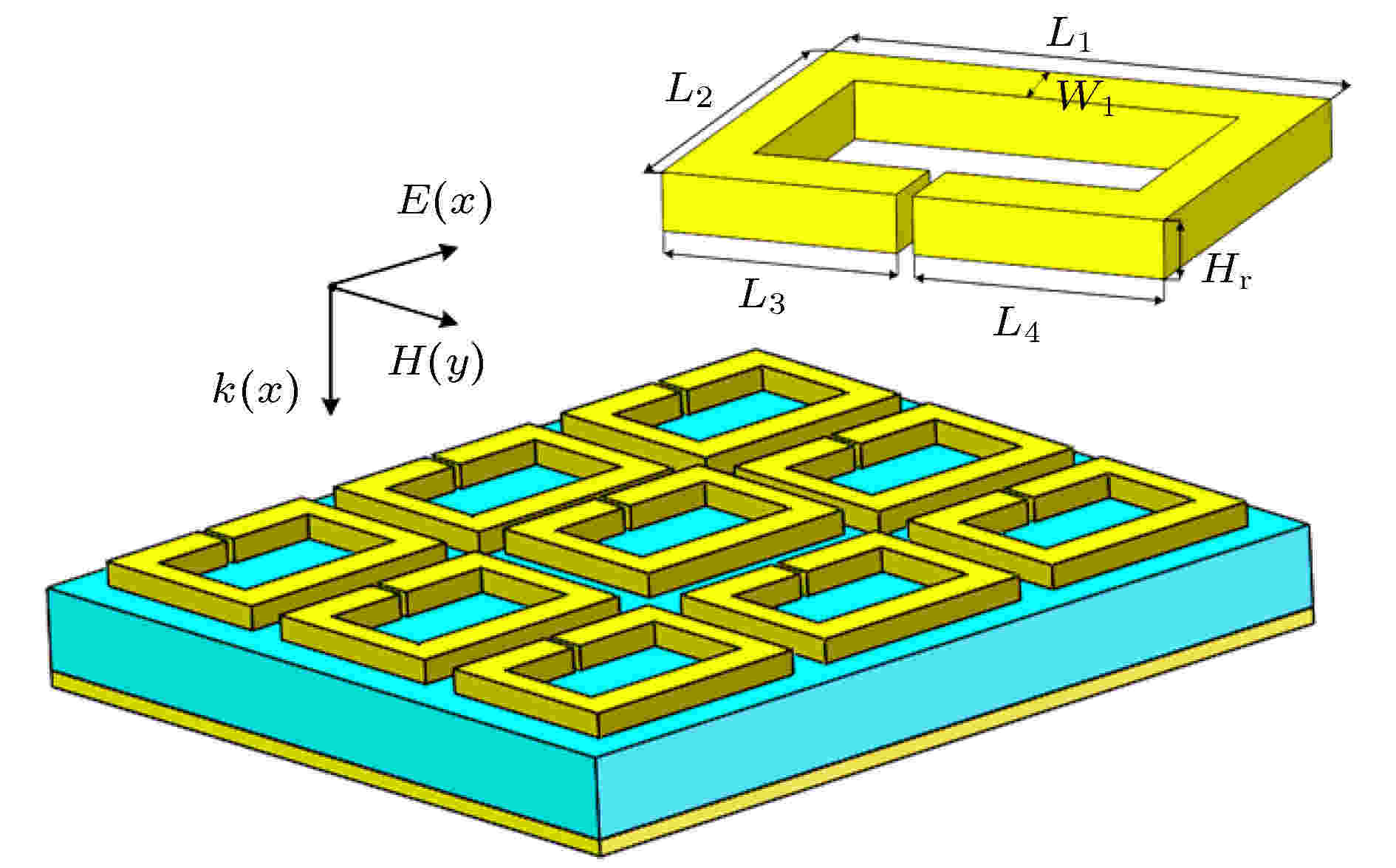 图 1 基于连续介质层和金属开口谐振环阵列的太赫兹超材料吸波器的结构示意图
图 1 基于连续介质层和金属开口谐振环阵列的太赫兹超材料吸波器的结构示意图Figure1. Schematic diagram of THz MM absorber based on continuous dielectric layer and metallic split-ring resonator array.
采用基于有限元法的电磁仿真软件的频域求解器对该太赫兹超材料吸波器的结构进行仿真优化. 在仿真过程中, 太赫兹波垂直入射到超材料吸波器表面, 波矢量k沿着z轴方向, 电场E沿着

当太赫兹波垂直入射, 且基于开口谐振环阵列的太赫兹超材料吸波器取如下优化的结构参数, 即












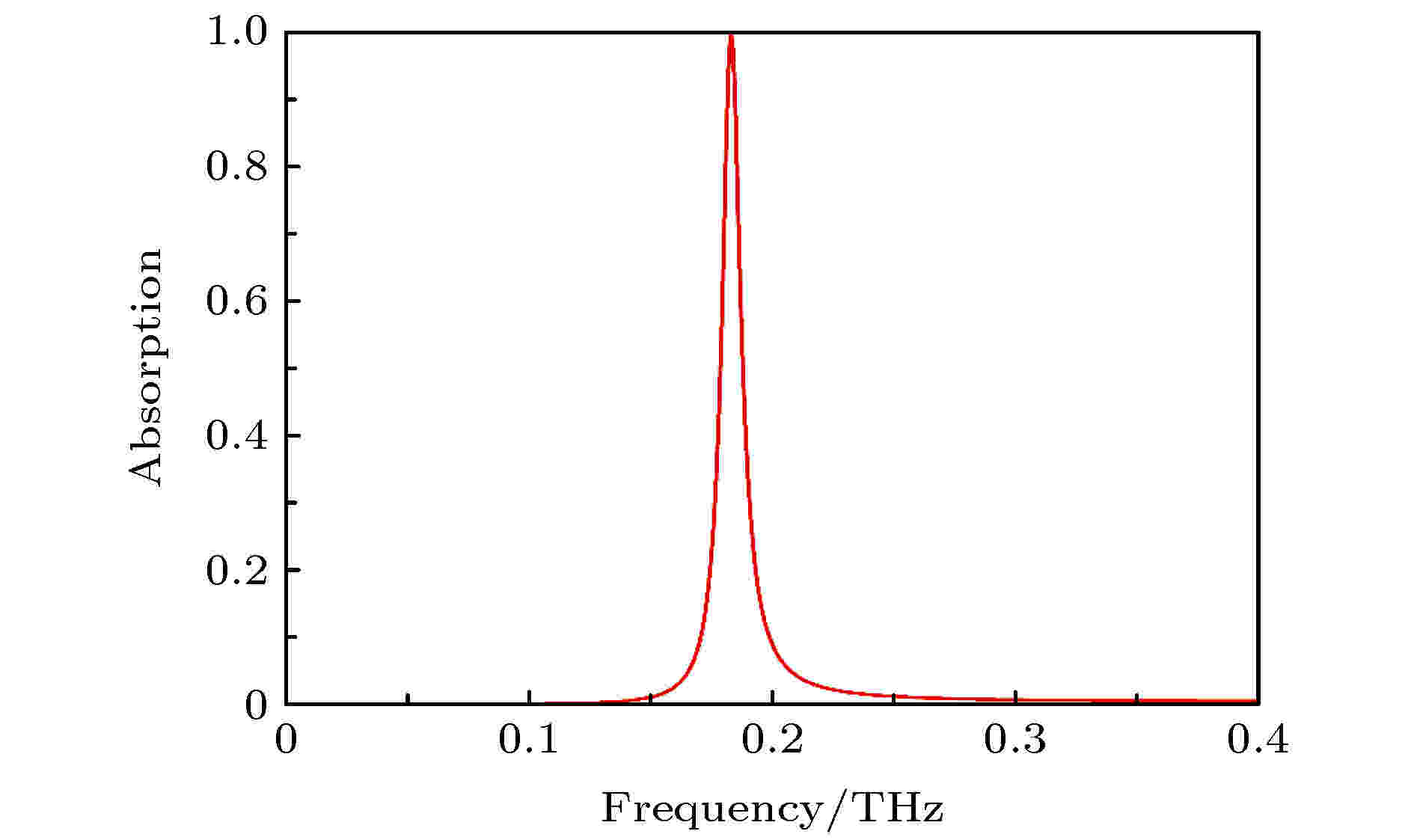 图 2 具有连续介质层的太赫兹超材料吸波器的吸收特性仿真曲线
图 2 具有连续介质层的太赫兹超材料吸波器的吸收特性仿真曲线Figure2. Simulated absorption characteristic curve of THz MM absorber with continuous dielectric layer.
为了进一步理解该太赫兹超材料吸波器的谐振机理, 数值仿真研究了谐振频率处的表面电场、表面电流及


 图 3 (a) 谐振频率处的表面电流分布; (b) 谐振频率处的表面电场分布
图 3 (a) 谐振频率处的表面电流分布; (b) 谐振频率处的表面电场分布Figure3. (a) Surface current distribution at the resonance frequency; (b) surface electric field distribution at the resonance frequency.
虽然, 开口谐振环阵列可对入射电磁场产生强烈谐振, 实现对谐振电磁场的局域增强, 然而, 从谐振频率处


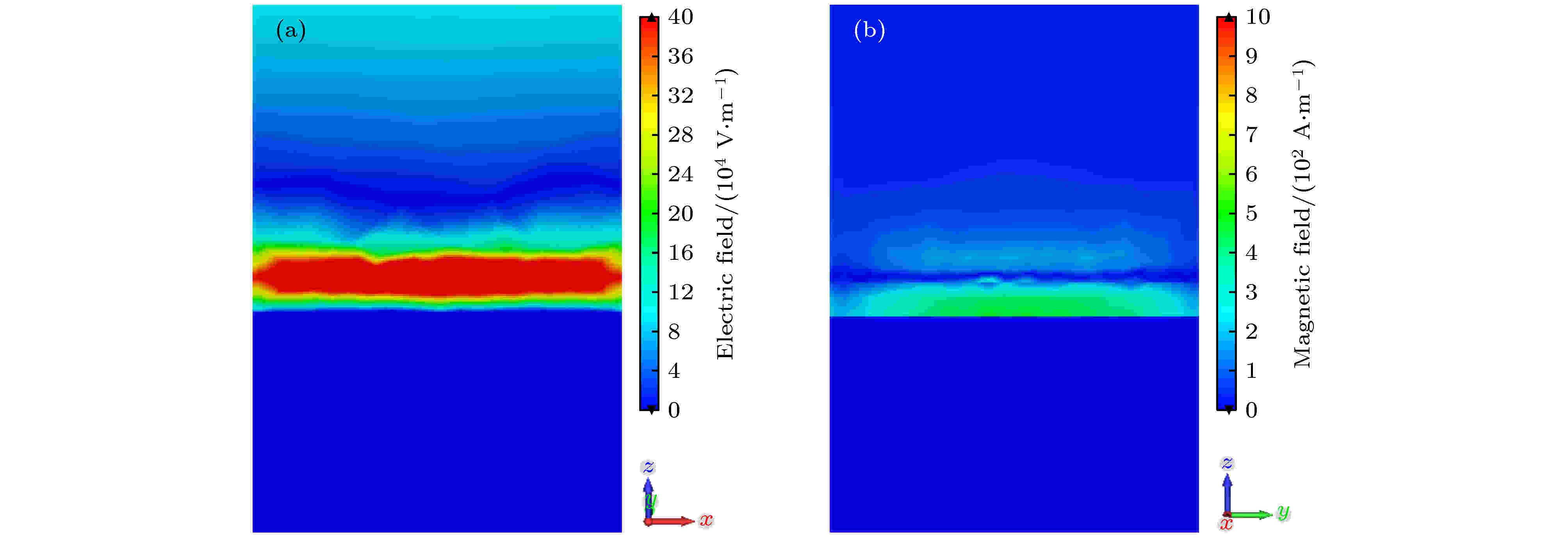 图 4 (a) 谐振频率处
图 4 (a) 谐振频率处

Figure4. (a) Electric field distribution at cross section of


2
2.2.传感特性与传感机理研究
为研究该太赫兹超材料吸波器作为传感器对待测分析物参数的电磁响应特性, 将待测分析物涂覆于超材料吸波器的金属谐振单元阵列表面, 并对其参数变化时的吸收特性进行一系列仿真分析.由于许多生物分子的折射率都处在1.0—2.0范围内, 因此, 在整个仿真过程中将待测生物分析物的折射率范围设定为1.0—1.8. 当涂覆于超材料吸波器表面的待测分析物的厚度固定为Ha = 0.3 μm(金属开口谐振环阵列的高度, 恰好将金属开口谐振环阵列浸没于待测分析物中)不变, 而折射率从n = 1增加到n = 1.8, 该太赫兹超材料吸波器的谐振频率发生明显红移(如图5所示). 通常, 传感器的折射率频率灵敏度定义为





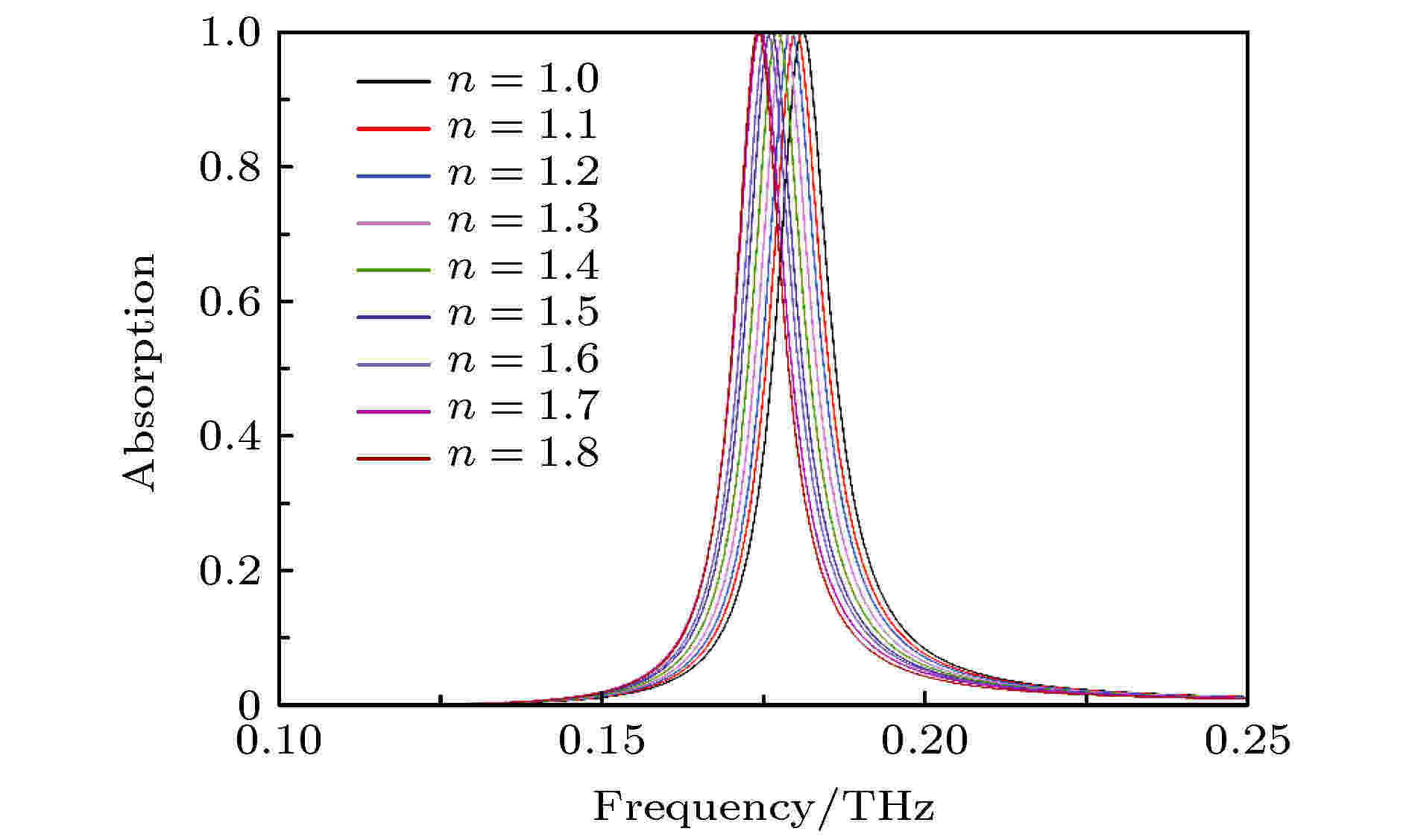 图 5 在分析物折射率从n = 1变化到n = 1.8时具有连续介质层的太赫兹超材料吸波器的吸收特性仿真曲线
图 5 在分析物折射率从n = 1变化到n = 1.8时具有连续介质层的太赫兹超材料吸波器的吸收特性仿真曲线Figure5. Simulated absorption characteristic curves of THz MM absorber with continuous dielectric layer under analyte refractive index changes from n = 1 to n = 1.8.
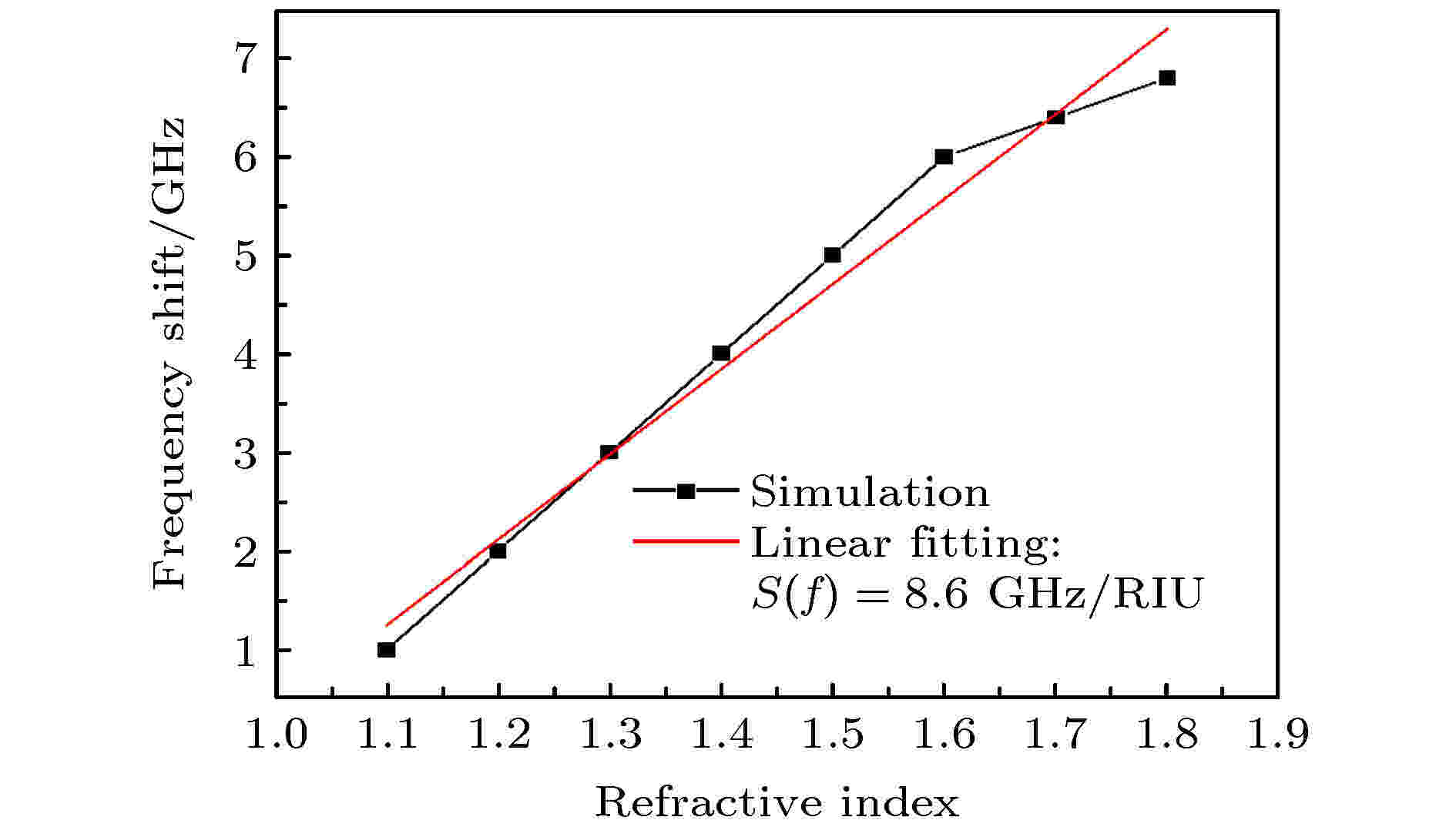 图 6 在分析物折射率从n = 1变化到n = 1.8时具有连续介质层的太赫兹超材料吸波器的谐振频率偏移及其线性拟合
图 6 在分析物折射率从n = 1变化到n = 1.8时具有连续介质层的太赫兹超材料吸波器的谐振频率偏移及其线性拟合Figure6. Resonance frequency shifts and linear fitting of THz MM absorber with continuous dielectric layer under analyte refractive index changes from n = 1 to n = 1.8.
为了对工作在不同频段的传感器性能进行更加合理的比较, 通常采用FOM值对传感器特性进行描述, 当传感器的灵敏度





由此可见, 基于连续介质层和开口谐振环阵列的太赫兹超材料吸波器可以作为折射率传感器实现对涂覆于其表面具有不同折射率的待测分析物的传感检测, 但是从其对应的折射率频率灵敏度

为了提高该太赫兹超材料吸波器的折射率频率灵敏度, 在所有参数均保持不变的情况下, 仅改变中间介质层的材料, 则传感器的折射率频率灵敏度发生了明显改变, 如图7所示. 当中间介质层材料为相对介电常数








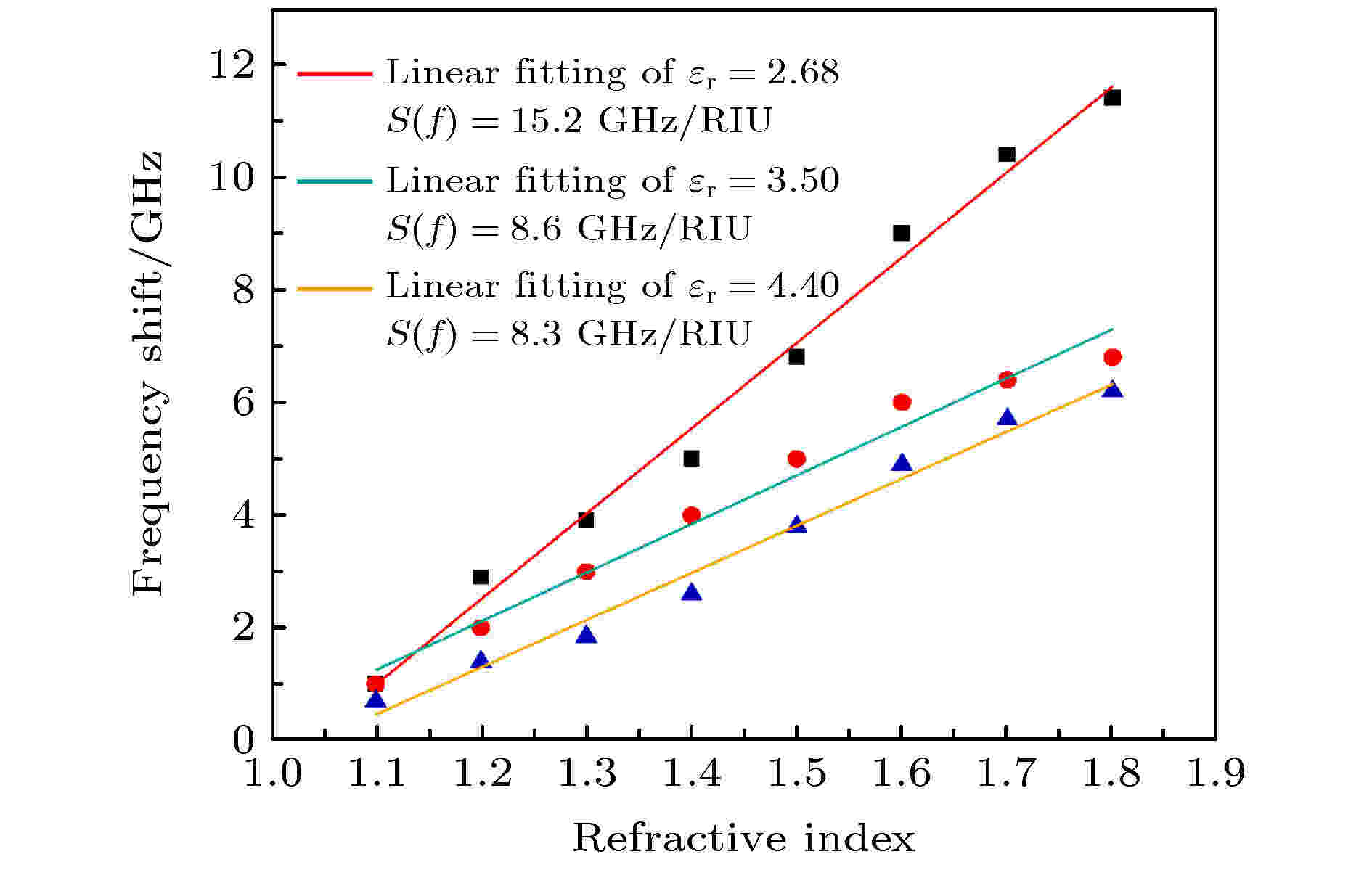 图 7 介质层材料的相对介电常数变化对传感器折射率频率灵敏度的影响
图 7 介质层材料的相对介电常数变化对传感器折射率频率灵敏度的影响Figure7. Influence of relative permittivity of dielectric layer material on the refractive index frequency sensitivity of the sensor.
以上仿真分析已经验证了所设计的基于连续介质层的太赫兹超材料吸波器对涂覆于其表面的待测分析物的折射率存在不同的电磁响应, 下面通过仿真分析深入探讨该太赫兹超材料吸波器的最大探测范围, 即可以检测的被测分析物的最大厚度.
如图8和图9所示: 当涂覆于超材料吸波器表面的待测分析物的厚度Ha从0.3 μm (金属开口谐振环阵列的高度, 恰好将金属开口环谐振阵列浸没于待测分析物中)逐渐增大到25 μm, 待测分析物与超材料吸波器表面的边缘场从部分接触逐步实现了充分的全接触, 于是太赫兹超材料吸波器的折射率频率灵敏度




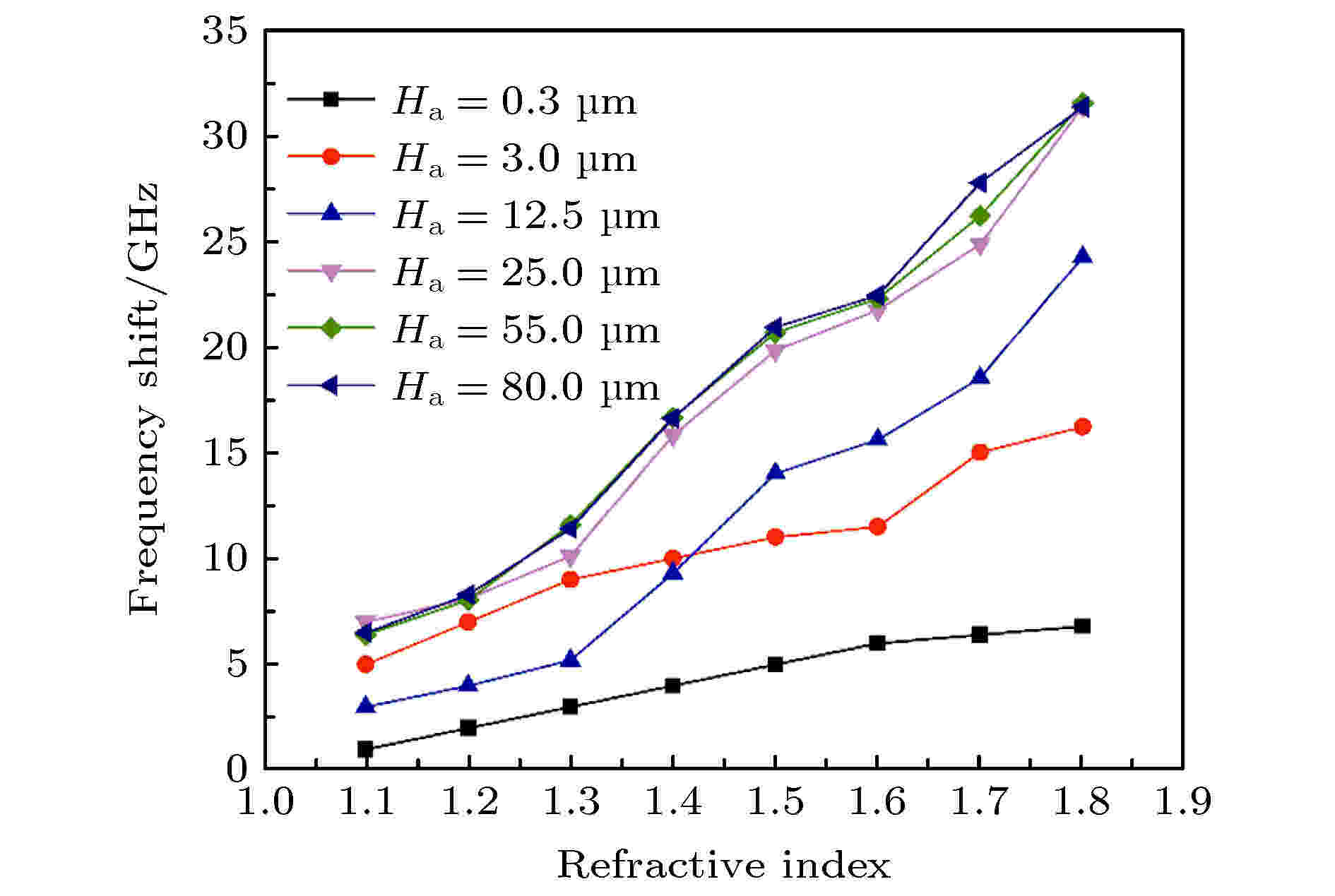 图 8 在分析物厚度不同条件下, 分析物折射率从n = 1变化到n = 1.8时具有连续介质层的太赫兹超材料吸波器的谐振频率偏移
图 8 在分析物厚度不同条件下, 分析物折射率从n = 1变化到n = 1.8时具有连续介质层的太赫兹超材料吸波器的谐振频率偏移Figure8. Resonance frequency shifts of THz MM absorber with continuous dielectric layer under analyte refractive index changes from n = 1 to n = 1.8 for different thicknesses of the analyte.
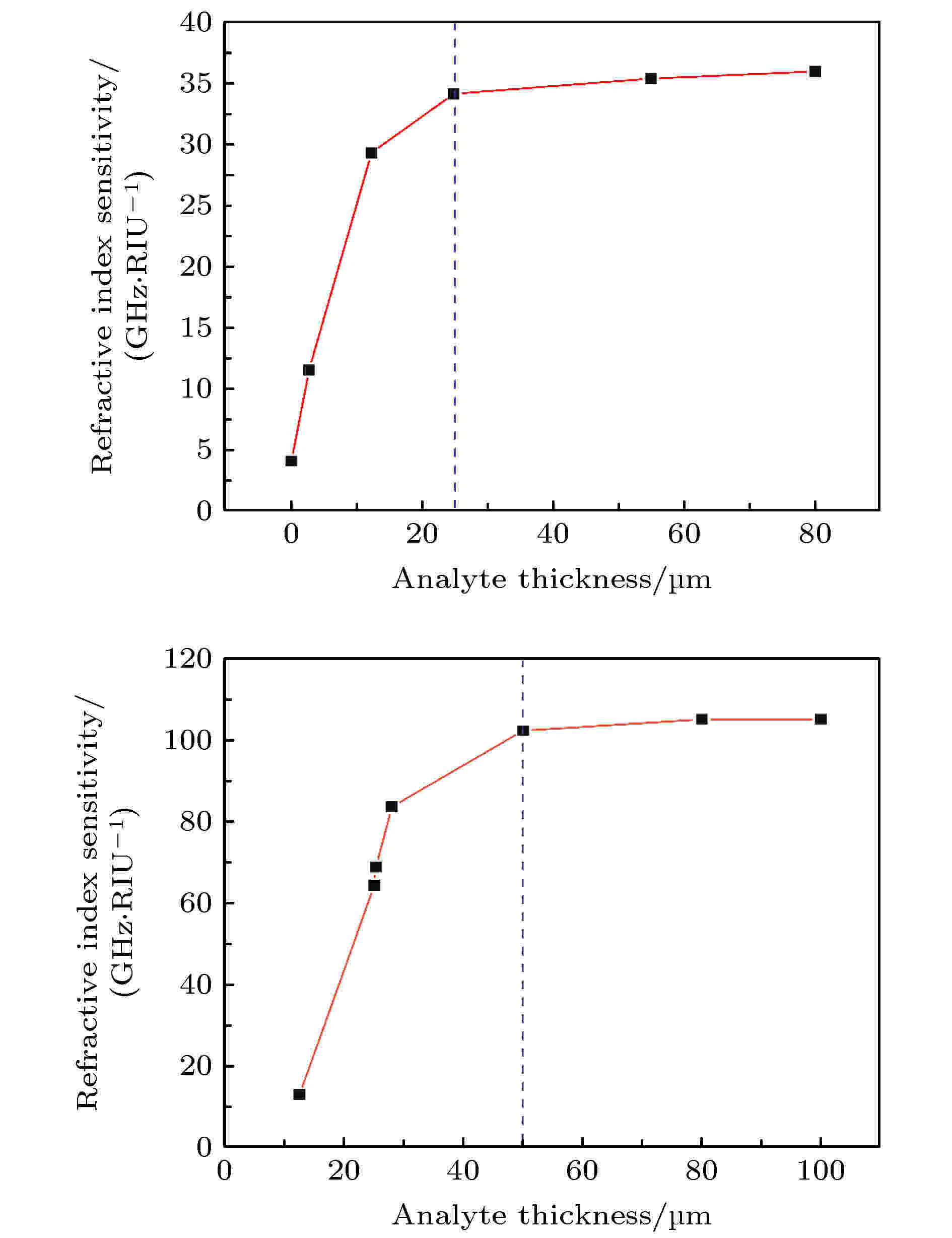 图 9 选用连续介质层的太赫兹超材料吸波器作为传感器时, 被测分析物厚度对传感器折射率频率灵敏度的影响
图 9 选用连续介质层的太赫兹超材料吸波器作为传感器时, 被测分析物厚度对传感器折射率频率灵敏度的影响Figure9. Influence of the thickness of the analyte to be measured on the refractive index frequency sensitivity of the sensor for the THz MM absorber with continuous dielectric layer.
因此, 对于该太赫兹超材料吸波器而言, 为获得较高的传感灵敏度, 应根据实际需要选择在金属谐振单元阵列表面涂覆较厚的待测分析物, 但是并不意味着折射率频率灵敏度会随着分析物厚度的增大而无限制的增大下去, 当待测分析物的厚度为80 μm时, 可以获得很高的传感灵敏度.
3.1.结构设计与仿真
基于对具有连续介质层的太赫兹超材料吸波器的传感特性与机理的深入分析, 我们知道, 连续介质层对谐振电磁场的强烈束缚, 限制了谐振电磁场与被测分析物之间的相互作用, 最终影响了太赫兹超材料吸波器作为传感器的折射率频率灵敏度. 虽然通过选用相对介电常数(折射率)较低的材料作为中间介质层, 可以在一定程度上改善传感器的灵敏度, 但是其作用仍然有限.为了进一步提升太赫兹超材料吸波器的折射率频率灵敏度, 减小中间介质层对谐振电磁场的束缚, 增强谐振电磁场与被测分析物之间的相互作用, 实现两者之间的紧密耦合, 提出了具有非连续介质层的太赫兹超材料吸波器结构, 如图10所示, 该超材料吸波器自下向上分别由底层的连续金属层、中间的非连续介质层和顶层的金属开口谐振环阵列构成, 其中非连续介质层与金属开口谐振环阵列的形状完全相同. 该太赫兹超材料吸波器所采用的材料和对应的结构参数与具有连续介质层的太赫兹超材料吸波器完全一致, 两者之间的唯一区别仅在于介质层的形态不同.
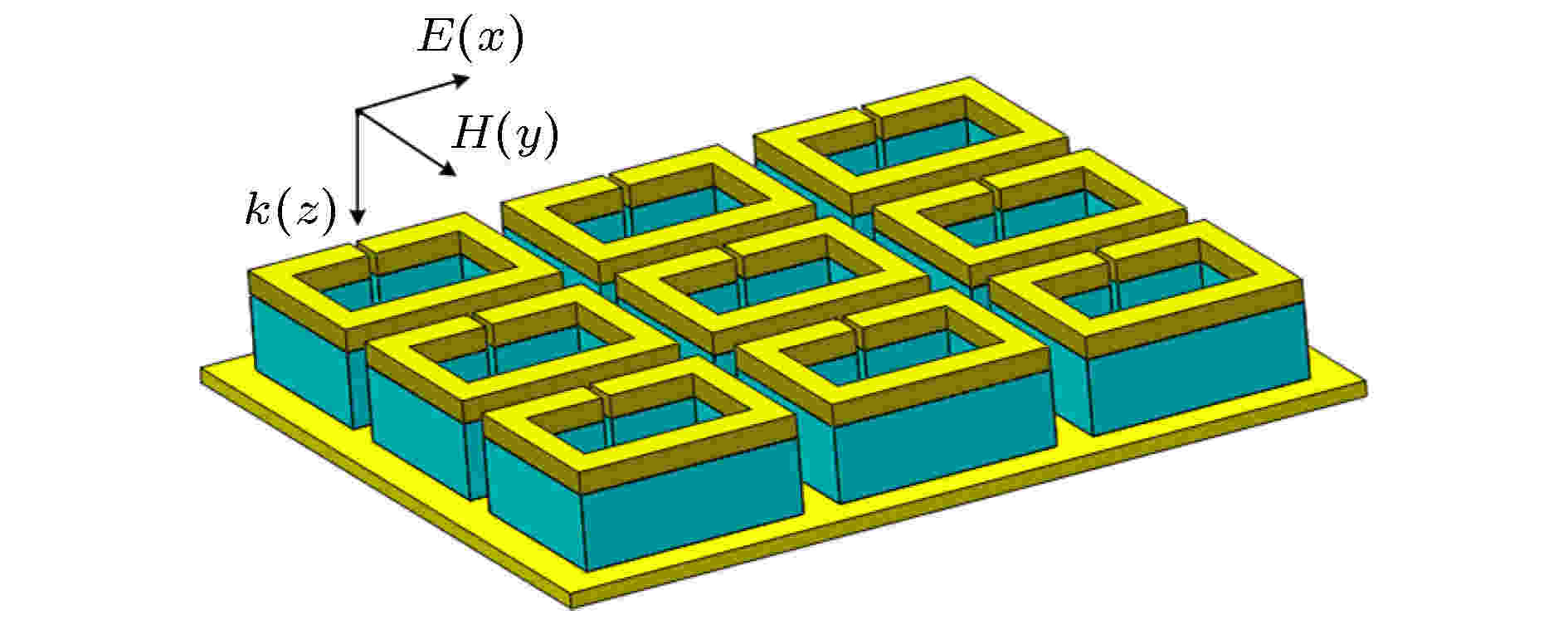 图 10 基于非连续介质层和金属开口谐振环阵列的太赫兹超材料吸波器的结构示意图
图 10 基于非连续介质层和金属开口谐振环阵列的太赫兹超材料吸波器的结构示意图Figure10. Schematic diagram of THz MM absorber based on discontinuous dielectric layer and metallic split-ring resonator array.
如图11所示, 当太赫兹波垂直入射时, 具有非连续介质层的太赫兹超材料吸波器在



 图 11 具有非连续介质层的太赫兹超材料吸波器的吸收特性仿真曲线
图 11 具有非连续介质层的太赫兹超材料吸波器的吸收特性仿真曲线Figure11. Simulated absorption characteristic curve of THz MM absorber with discontinuous dielectric layer.
2
3.2.传感特性与传感机理研究
当涂覆于超材料吸波器表面的待测分析物的厚度固定为Ha = 25.3 μm (中间介质层的高度与金属开口谐振环阵列的高度之和, 恰好将金属开口谐振环阵列浸没于待测分析物中)不变, 而折射率从n = 1增加到n = 1.8, 如图12所示, 该太赫兹超材料吸波器的谐振频率发生明显红移, 对应的吸收率逐渐增大. 当分析物折射率为n = 1.8时, 与具有连续介质层的太赫兹超材料吸波器一样, 实现了对入射电磁波的“完美”吸收.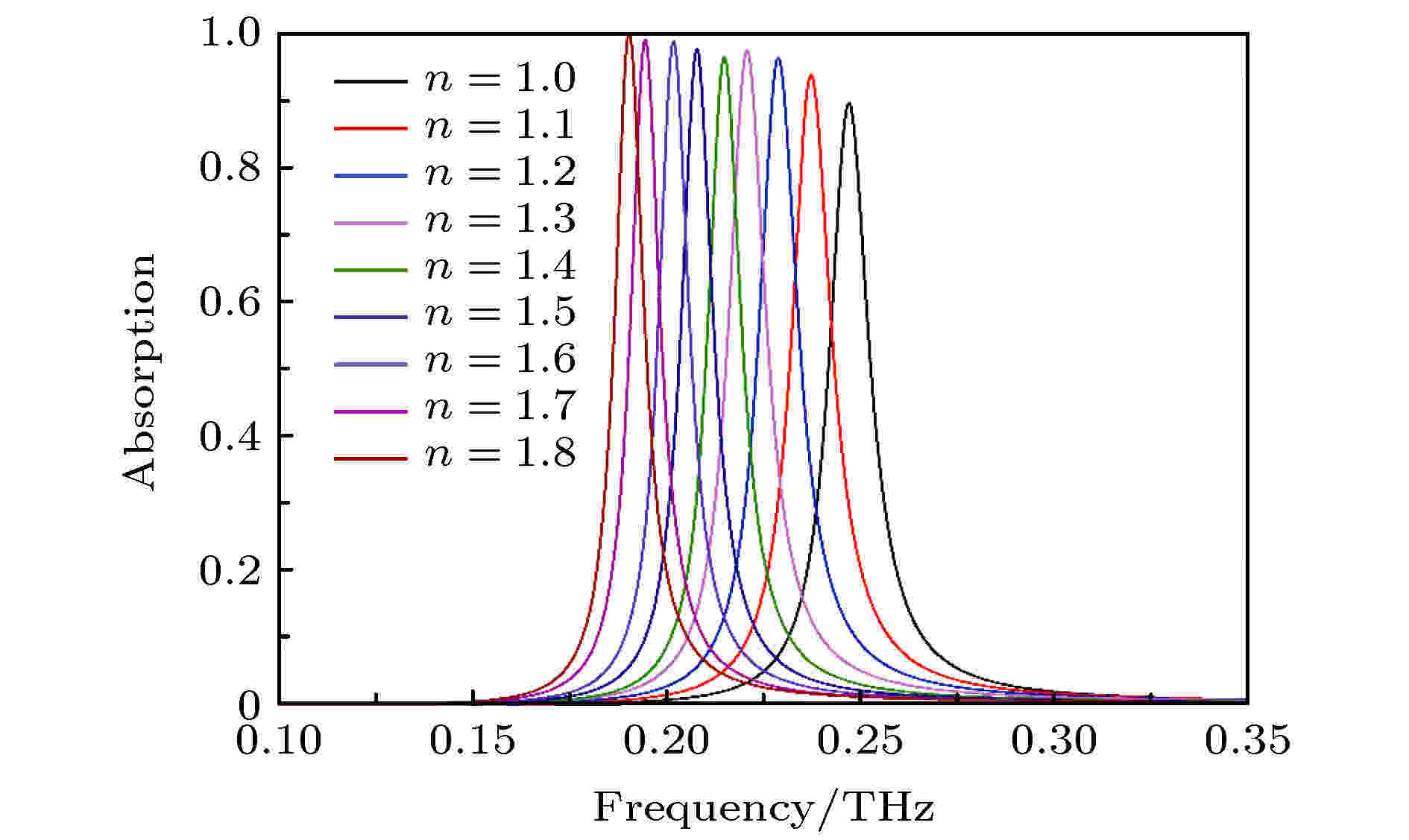 图 12 在分析物折射率从n = 1变化到n = 1.8时具有非连续介质层的太赫兹超材料吸波器的吸收特性仿真曲线
图 12 在分析物折射率从n = 1变化到n = 1.8时具有非连续介质层的太赫兹超材料吸波器的吸收特性仿真曲线Figure12. Simulated absorption characteristic curves of THz MM absorber with discontinuous dielectric layer under analyte refractive index changes from n = 1 to n = 1.8.
如图13所示, 当待测分析物的厚度固定为Ha = 25.3 μm, 而折射率以0.1为间隔从n = 1增加到n = 1.8时, 该太赫兹超材料吸波器所对应的折射率频率灵敏度


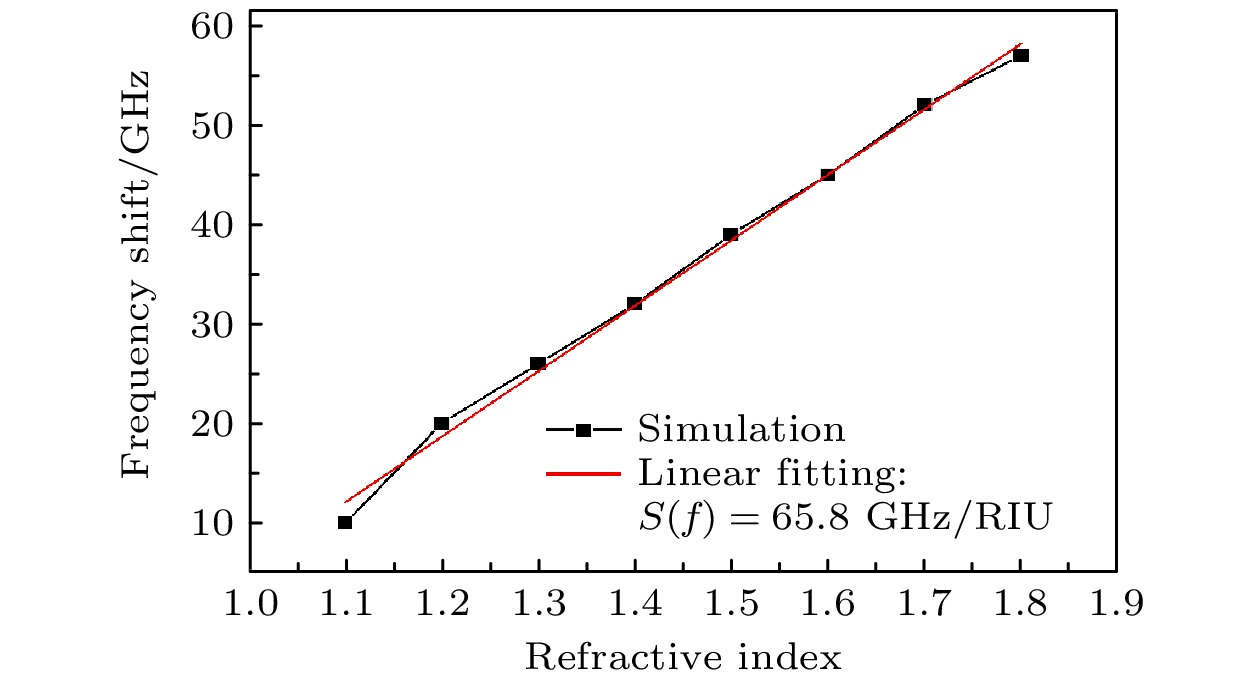 图 13 在分析物折射率从n = 1变化到n = 1.8时具有非连续介质层的太赫兹超材料吸波器的谐振频率偏移及其线性拟合
图 13 在分析物折射率从n = 1变化到n = 1.8时具有非连续介质层的太赫兹超材料吸波器的谐振频率偏移及其线性拟合Figure13. Resonance frequency shifts and linear fitting of THz MM absorber with discontinuous dielectric layer under analyte refractive index changes from n = 1 to n = 1.8.
如图14和图15所示: 当涂覆于超材料吸波器表面的待测分析物的厚度Ha从12.5 μm (中间介质层高度的一半)增大到25 μm (中间介质层的高度), 继续增大到25.3 μm (中间介质层的高度与金属开口谐振环阵列的高度之和, 恰好将金属开口谐振环阵列浸没于待测分析物中), 直到50 μm时, 待测分析物与超材料吸波器的边缘场从部分接触逐步实现了紧密的全接触, 于是太赫兹超材料吸波器的折射率频率灵敏度










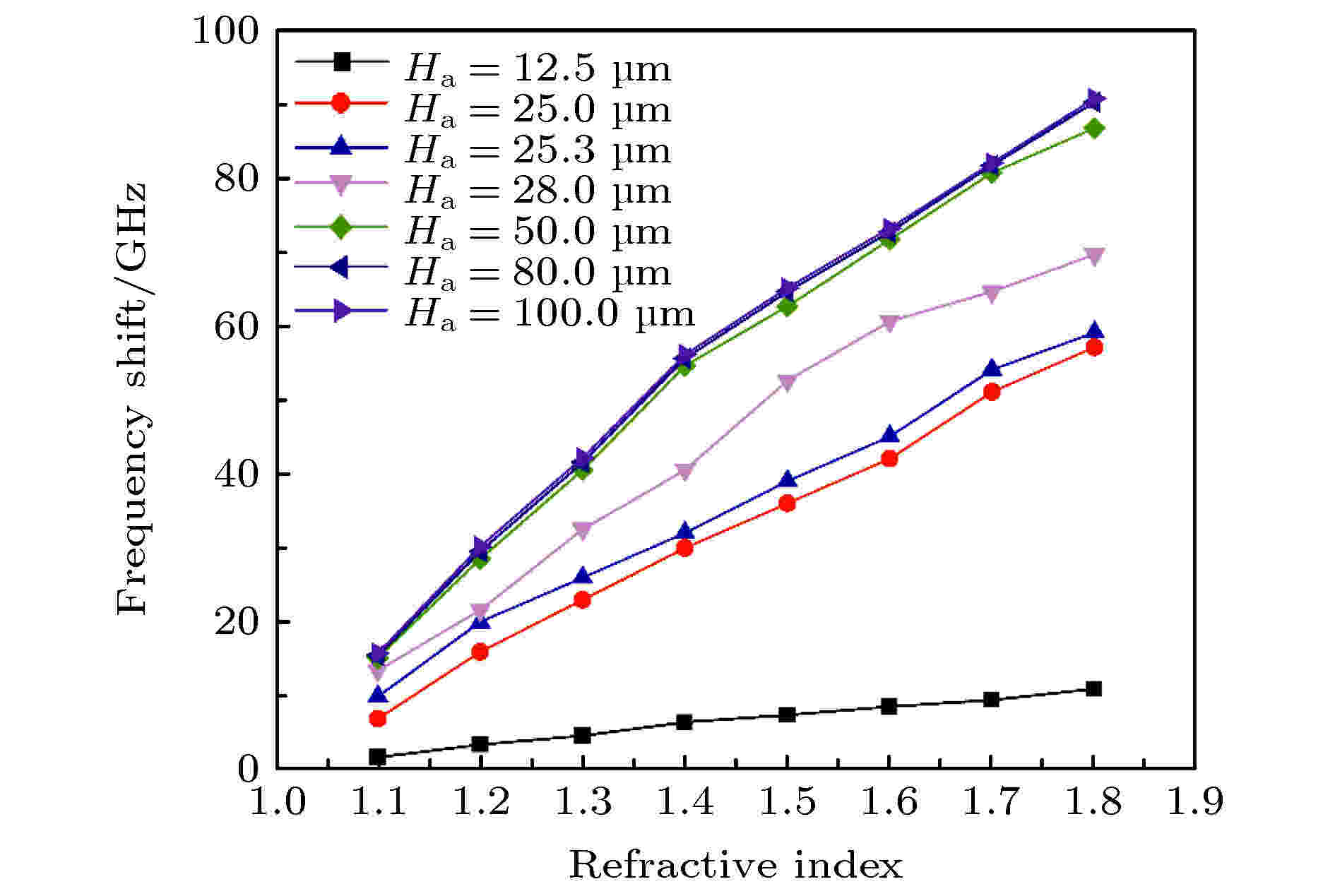 图 14 在分析物厚度不同条件下, 分析物折射率从n = 1变化到n = 1.8时具有非连续介质层的太赫兹超材料吸波器的谐振频率偏移
图 14 在分析物厚度不同条件下, 分析物折射率从n = 1变化到n = 1.8时具有非连续介质层的太赫兹超材料吸波器的谐振频率偏移Figure14. Resonance frequency shifts of THz MM absorber with discontinuous dielectric layer under analyte refractive index changes from n = 1 to n = 1.8 for different thicknesses of the analyte.
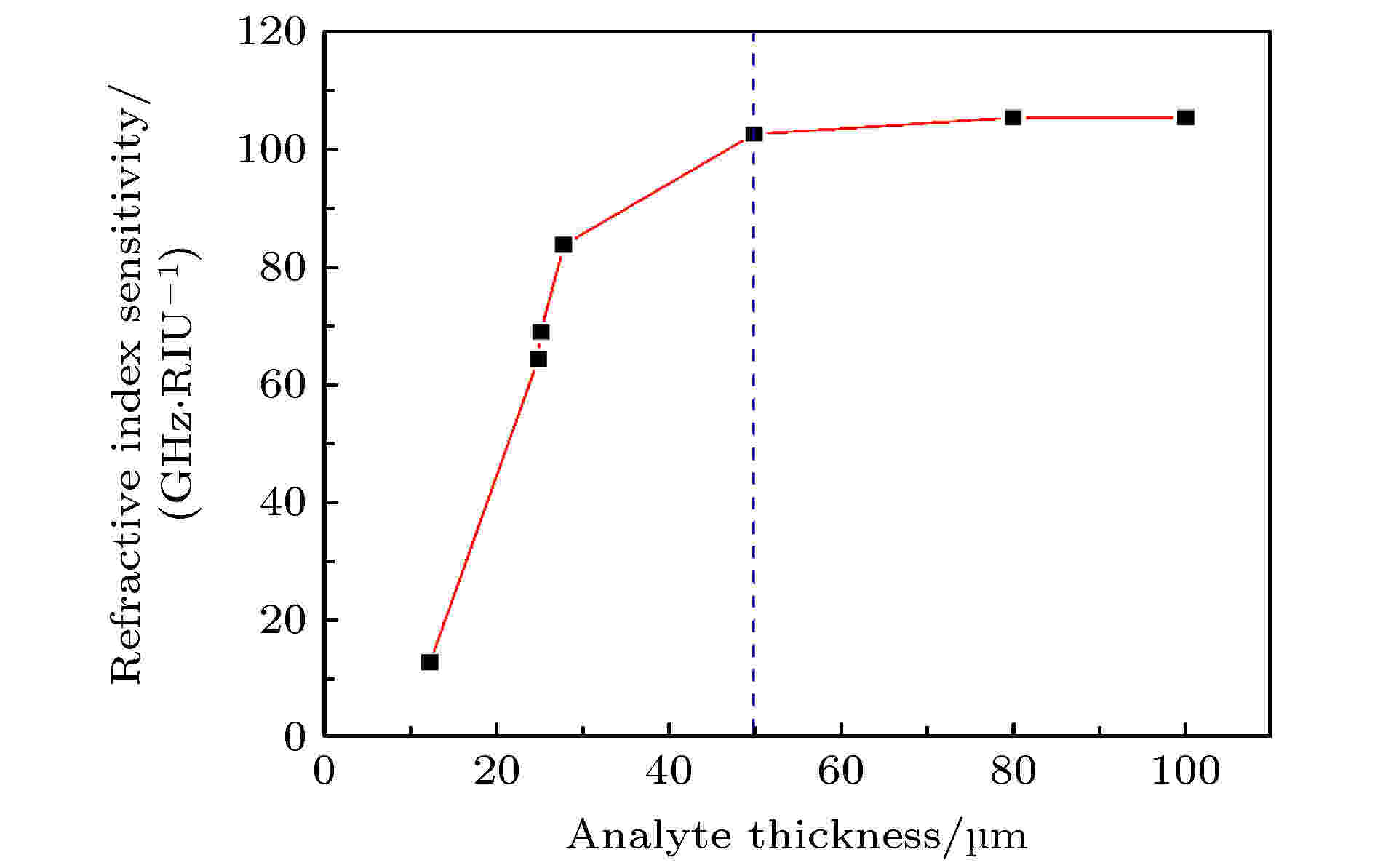 图 15 选用非连续介质层的太赫兹超材料吸波器作为传感器时, 被测分析物厚度对传感器折射率频率灵敏度的影响
图 15 选用非连续介质层的太赫兹超材料吸波器作为传感器时, 被测分析物厚度对传感器折射率频率灵敏度的影响Figure15. Influence of the thickness of the analyte to be measured on the refractive index frequency sensitivity of the sensor for the THz MM absorber with discontinuous dielectric layer.
仿真结果表明, 基于连续介质层与非连续介质层的太赫兹超材料吸波器对待测分析物的最大探测厚度基本都可以达到80 μm. 对基于连续介质层和非连续介质层的太赫兹超材料吸波器在不同待测分析物厚度情况下的折射率频率灵敏度进行比较会发现(比较图9和图15), 当待测分析物厚度较薄(Ha≤12.5 μm)时, 选用具有连续介质层的太赫兹超材料吸波器作为传感器可获得更高的灵敏度, 而当待测分析物厚度较厚(Ha≥25 μm), 选用具有非连续介质层的太赫兹超材料吸波器作为传感器获得的传感灵敏度会更高.
4.1.结构设计与仿真
为了进一步减小介质层对谐振场的束缚, 增强谐振场与被测分析物之间的相互作用, 提升太赫兹超材料吸波器的折射率频率灵敏度, 提出具有微腔结构的太赫兹超材料吸波器, 如图16所示. 该超材料吸波器自下向上分别由底层的连续金属板、中间的微腔结构、顶层的金属开口谐振环阵列和支撑层构成. 所谓的微腔结构其实就是在底层的连续金属板与顶层的支撑层之间形成的微米级别的空隙, 填充到微腔结构中的待测分析物可充当该太赫兹超材料吸波器的中间介质层. 该太赫兹超材料吸波器所采用的材料和对应的结构参数仍然与具有连续介质层的太赫兹超材料吸波器保持完全一致, 且金属谐振单元阵列的下表面与底层连续金属层之间的距离设置为Hd = 25 μm. 图 16 待测分析物充当介质层的太赫兹超材料吸波器的结构示意图
图 16 待测分析物充当介质层的太赫兹超材料吸波器的结构示意图Figure16. Schematic diagram of THz MM absorber whose analyte to be measured acts as dielectric layer.
如图17所示, 当太赫兹波垂直入射时, 该太赫兹超材料吸波器在



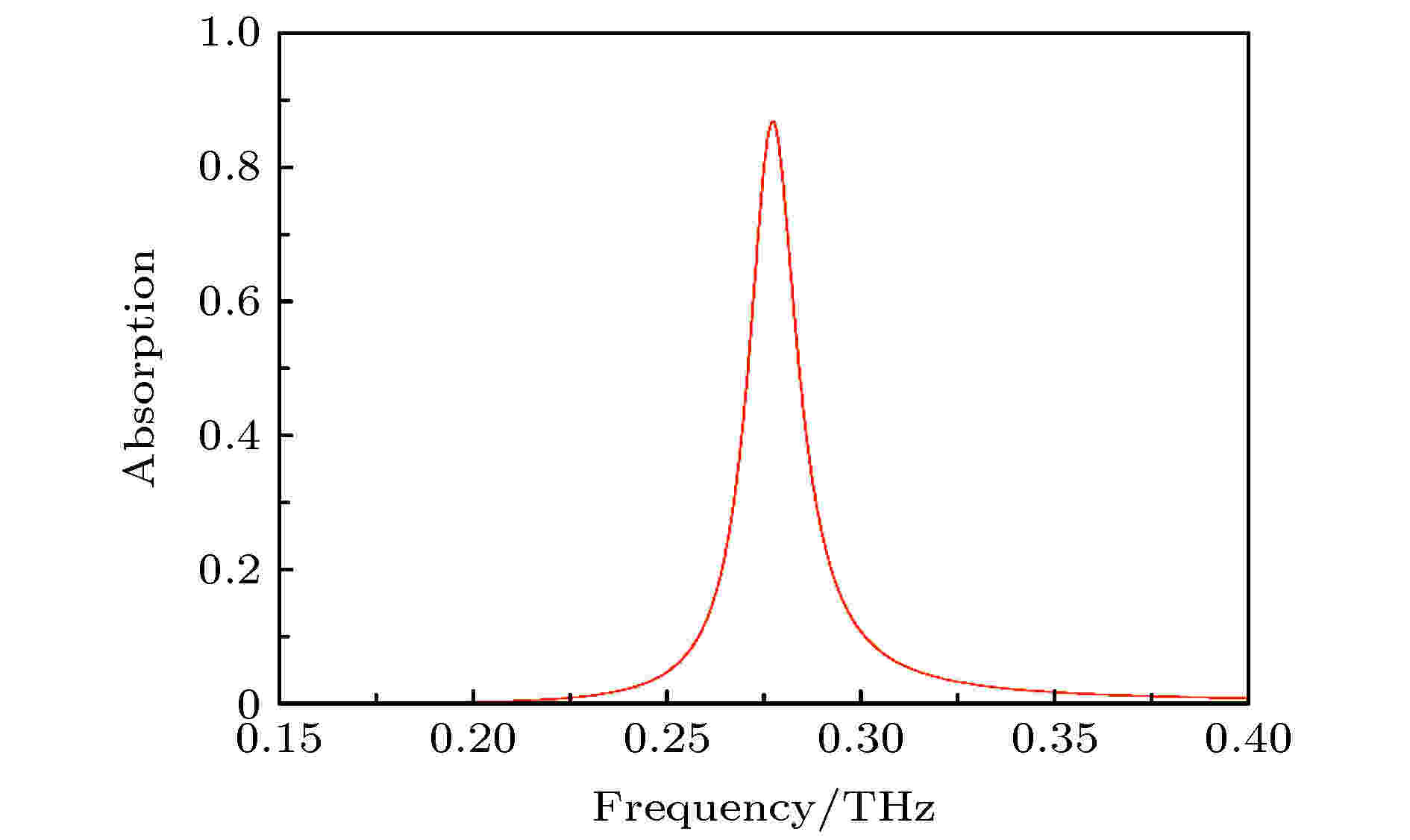 图 17 未填充待测分析物的太赫兹超材料吸波器的吸收特性仿真曲线
图 17 未填充待测分析物的太赫兹超材料吸波器的吸收特性仿真曲线Figure17. Simulated absorption characteristic curve of THz MM absorber without filling the analyte to be measured.
2
4.2.传感特性与传感机理研究
充当中间介质层的待测分析物厚度固定为Ha = 25.3 μm (金属开口谐振环阵列的上表面与底面连续金属板之间的高度, 恰好将金属谐振环阵列浸没于待测分析物中)不变, 而折射率从n = 1增加到n = 1.8, 如图18所示, 该太赫兹超材料吸波器的谐振频率同样发生明显红移, 对应的吸收率逐渐增大. 当分析物折射率为n = 1.8时, 实现了对入射电磁波的“完美”吸收.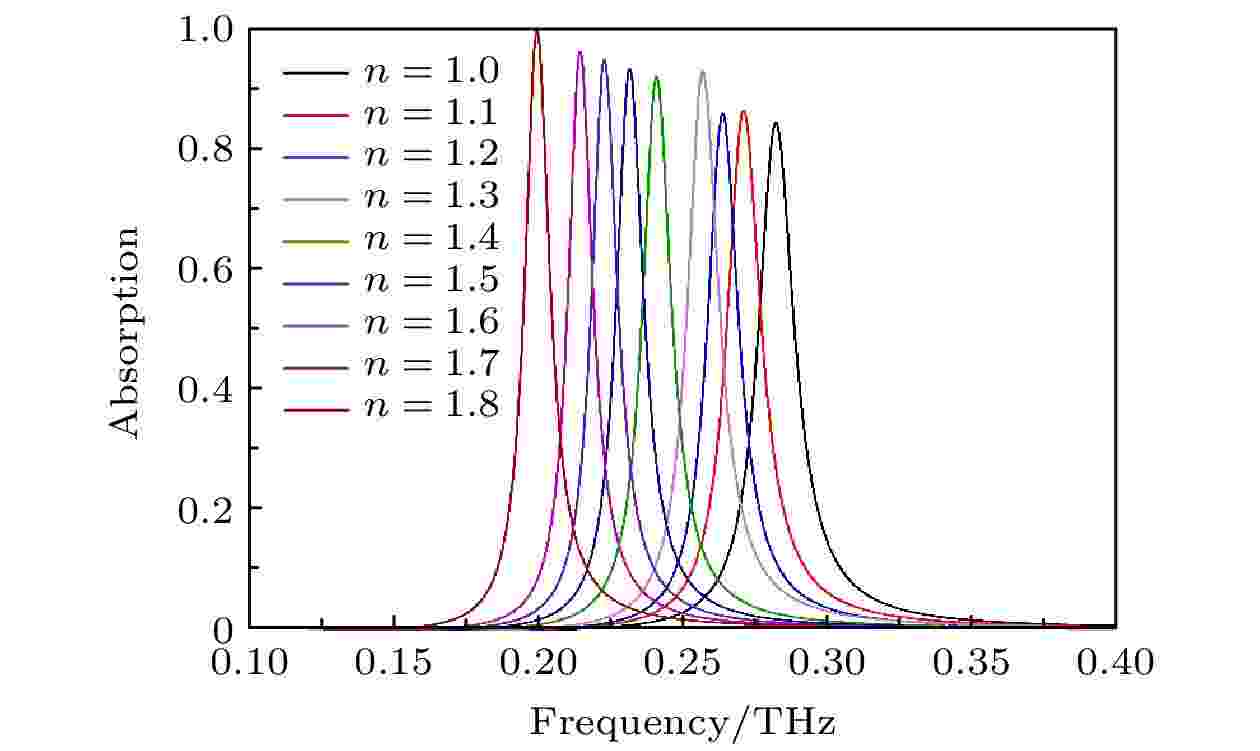 图 18 分析物折射率从n = 1变化到n=1.8时具有微腔结构的太赫兹超材料吸波器的吸收特性仿真曲线
图 18 分析物折射率从n = 1变化到n=1.8时具有微腔结构的太赫兹超材料吸波器的吸收特性仿真曲线Figure18. Simulated absorption characteristic curve of THz MM absorber with microcavity structure under analyte refractive index range from n = 1 to n = 1.8.
如图19所示, 当待测分析物的厚度固定为Ha = 25.3 μm, 而折射率以0.1为间隔从n = 1增加到n = 1.8时, 该太赫兹超材料吸波器所对应的折射率频率灵敏度

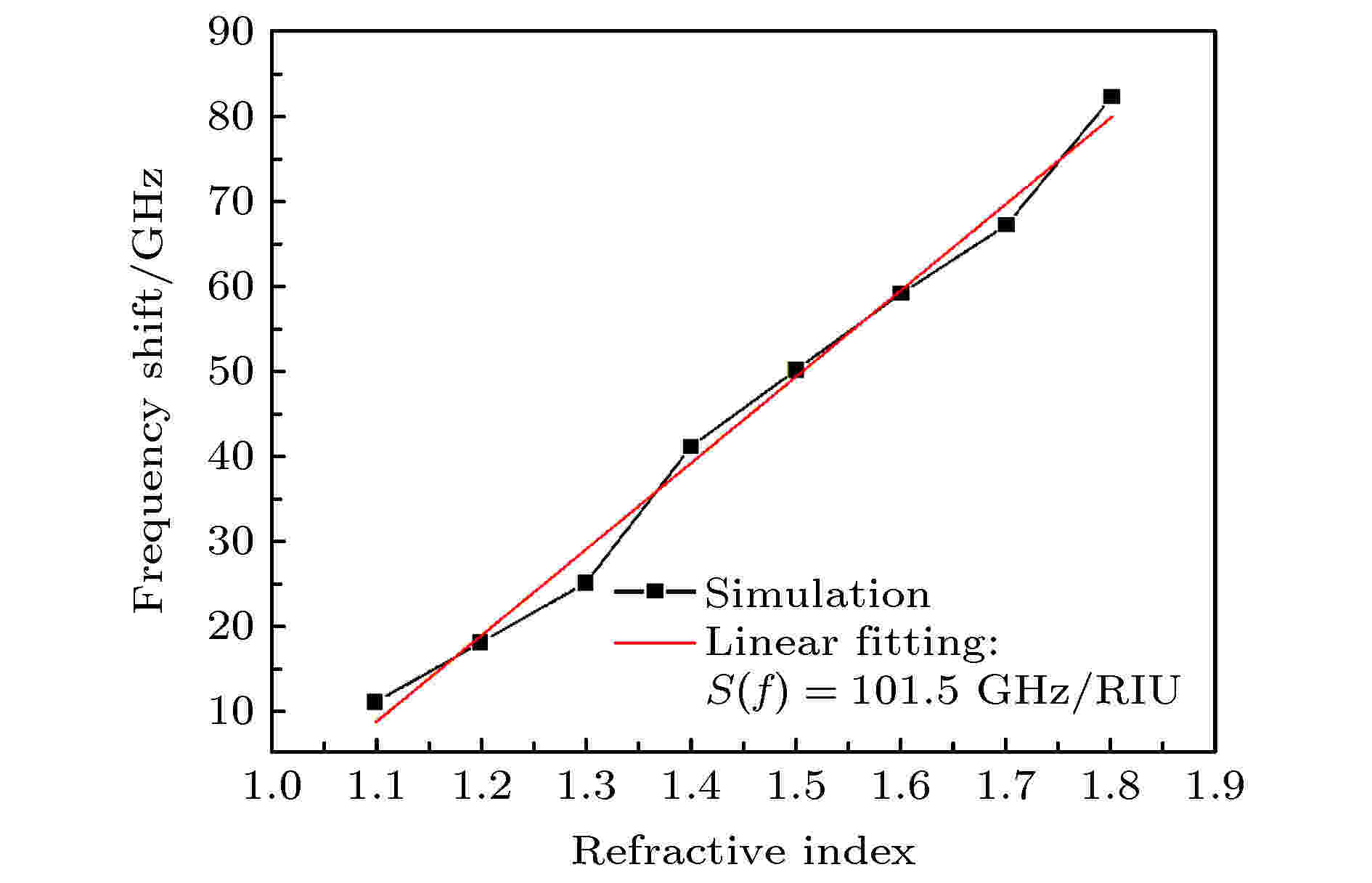 图 19 分析物折射率从n = 1变化到n = 1.8时具有微腔结构的太赫兹超材料吸波器的谐振频率偏移及其线性拟合
图 19 分析物折射率从n = 1变化到n = 1.8时具有微腔结构的太赫兹超材料吸波器的谐振频率偏移及其线性拟合Figure19. Resonance frequency shifts and linear fitting of THz MM absorber with microcavity structure under analyte refractive index changes from n = 1 to n = 1.8.
表1分别列举了具有连续介质层、非连续介质层和微腔结构的太赫兹超材料吸波器的吸收特性参数及其作为传感器的传感特性参数. 从表1可以看出, 不断削弱中间介质层对谐振场的局限作用, 一方面会降低太赫兹超材料吸波器谐振峰的吸收率、谐振峰半高宽和品质因数, 但是另一方面会大幅提升太赫兹超材料吸波器作为传感器的折射率灵敏度和FOM值.
| 太赫兹超材料吸波器的 吸收与传感特性参数 | 具有不同介质层的太赫兹超材料吸波器 | ||
| 连续介质层 | 非连续介质层 | 微腔结构 | |
| 谐振频率/THz | 0.183 | 0.245 | 0.277 |
| 吸收率/% | 99.97 | 93.30 | 86.60 |
| 谐振峰半高宽FWHM/GHz | 9.3 | 13.0 | 15.0 |
| 品质因数Q | 19.7 | 18.8 | 18.4 |
| 折射率灵敏度S/(GHz·RIU–1) | 8.6 | 65.8 | 101.5 |
| FOM值 | 0.92 | 5.06 | 6.77 |
表1太赫兹超材料吸波器的参数对比
Table1.Comparison of parameters of THz MM absorbers
